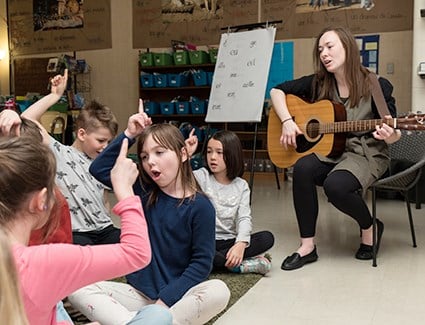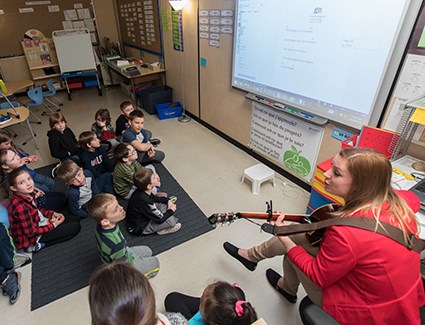 In order to help their students learn a new language, two French immersion teachers at École River Heights School first had to do some unique learning of their own.
In order to help their students learn a new language, two French immersion teachers at École River Heights School first had to do some unique learning of their own.
Teachers Jessica Brown and Marie-Pierre Michaud wanted to use short songs to help their Grade 2 and Grade 3 students become more familiar with French, but before they could teach with music they first had to learn how to play the guitar.
"This literacy framework was born of the understanding that phonics, phonological and phonemic awareness are key to reading and writing in French," Michaud said. "Recognizing the power of music to transform learning experiences and bolster memory recall, Jessica and I decided that we would learn how to play the guitar to support literacy learning."
Michaud and Brown use more than two dozen original songs to familiarize students with the most common sounds of the French language but the songs are only one component of the literacy instruction that takes place each day in their classrooms.
"Daily learning must be extended beyond the songs to ensure that students connect the sounds to the appropriate letter combinations," Michaud explained. "This is achieved through a variety of activities, games, tasks and explicit decoding strategies, all of which connect naturally to the rich instruction of sounds that occurs with the see-say-spell and word work components of MIMI (PWIM)."
After more than a year of using the musical approach to literacy instruction, Brown says regular assessment shows student growth in language acquisition. The collection of data allows her to track improvement, target intervention to improve mastery of the sounds on both a class and individual level and share individualized student progress with parents so they can support their child at home.
 "In the classroom, student acquisition of phonics has improved dramatically in response to this responsive instruction. This year, I tested by students for 64 sounds in mid-October and again in the beginning of November . . . in that period my 21 Grade 2 students gained an average of 15 sounds over the course of October, which translates to an average 35 per cent reduction in unknown sounds," she said.
"In the classroom, student acquisition of phonics has improved dramatically in response to this responsive instruction. This year, I tested by students for 64 sounds in mid-October and again in the beginning of November . . . in that period my 21 Grade 2 students gained an average of 15 sounds over the course of October, which translates to an average 35 per cent reduction in unknown sounds," she said.
"Another way to look at this is that the average student improved their sound recognition by 114 per cent, which means that they more than doubled the number of sounds they recognize in a one-month period."
At the beginning of 2016-17 school year, nine students in Brown's Grade 2 class were reading at or above grade level while 11 students were below grade level. The year ended with students, on average, improving by 8.5 reading levels, 2.5 levels more than expected for that grade. Four students were still reading below grade level, however two of those students were just one step below after experiencing significant growth during the year.
"They were considered success stories by our staff even though they were still one level below," Brown said.
Elliot LeBlanc a Grade 3 student, said using what he's learned through the songs helps him decode words while reading.
"When I don't know a word I just use these sounds to spell the word out and then I read it."
Adds Allyson Gurney, a Grade 2 student: "It's helped me with my writing. When I am trying to sound out a word and spell it I use the songs that I learned in class to sound it out and spell it."
Vice-Principal Deena Shyluk said using music and song as a strategy to boost learning is just one example of the creative approaches used by teachers to help students learn.
"As a music lover I was so happy to hear the sounds of children singing ringing through the halls of the school. I was even more excited when I found that the songs that the students were singing were very intentionally designed to promote French language learning."
The best testimony of the effort's success at building students' familiarity with French and creating excitement about language learning comes from the parents who hear their children singing the songs at home.
"Parents and students alike have communicated to us their appreciation of this approach to literacy instruction," Michaud said. "Indeed, one of our student's infectious singing of the songs at home convinced his mother to incorporate the songs into her classroom literacy instruction. Another parent communicated to us that his child sings so much at home that her younger sister, age 3, is now singing along with her!"